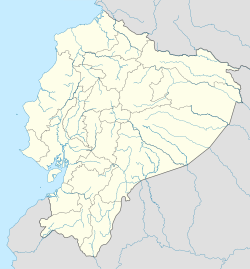| Riobamba | ||
 | ||
Coat of arms and flag  | ||
| Salutation | Sultana de los Andes Ciudad de las Primicias Corazón de la Patria | |
|---|---|---|
| State | Ecuador | |
| Region | Sierra | |
| Altitude | 2,754 m a.s.l. | |
| Surface | 59.05 km² | |
| Inhabitants | 156.723 (2010 census)--> | |
| Name inhabitants | Riobambeño/to | |
| Prefix tel | 593 3 | |
| POSTAL CODE | EC060150 | |
| Time zone | UTC-5 | |
Position
| ||
| Tourism site | ||
| Institutional website | ||
Riobamba is a city ofEcuador, located in the region of Sierra.
To know
Among landscapes dominated by high volcanoes, Riobamba is a provincial city with interesting colonial architecture. It also has a very pleasant climate, from eternal spring. Being the provincial capital, Riobamba is far from quiet and appears quite busy even on weekends, when the inhabitants come down from the nearby villages to sell their products at the Sunday market. Riobamba is renowned among those who have a passion for trekking and especially those who are passionate about rope climbing. The lazy ones are satisfied with the excursion aboard the Nariz del Diablo tourist train (Nostril of the devil), which runs through uncommon landscapes.
Background
In 1923, a human skull considered to be the oldest found in Ecuador was found in the locality of Chalán, a few kilometers from Riobamba and in the direction of the village of Punin; he was called "the man of Punín" and it was established that he lived in 3,000 BC.
In pre-Columbian times, the largest Inca city in the territory in the Ecuadorian Andes was Tomebamba, on the site of today's Cuenca. A provincial governor (tocricoc) was based in Latacunga not far from Riobamba.
Riobamba was founded on August 15, 1534 by Diego de Almagro, on the site of Liribamba, the millennial capital of the Puruhaes which today is Villa La Unión. It was the first Spanish city in the territory that today constitutes theEcuador. In colonial times it was part of the Audiencia Reale of Quito, an administrative subdivision of the viceroyalty of Peru. It was devastated by a terrible earthquake in 1797 and moved to its current location.
After the expulsion of the Spaniards, Riobamba became part of the Great Colombia and in 1830 of the Republic of Quito which subsequently took the name of the Republic of Ecuador.
Economic development came with the inauguration of the railway that connected it to Quito on one side and to the port of Guayaquil on the other. Riobamba was the third largest city at the time countryIn the 2nd and 3rd decade of the 20th century Riobamba changed its face, taking on an urban aspect. Many eclectic style multi-storey buildings were built on what had hitherto been an ensemble of haciendas and agricultural farms. A first example was that of the Bellavista neighborhood, begun in 1924 on land belonging to the "La Trinidad" estate, acquired by the Levi brothers.
The streets were paved and equipped with sidewalks, parks were arranged and monuments were erected. The engine of this feverish building activity was the loans granted by the credit institution "Sociedad Bancaria del Chimborazo". Its failure in 1926 caused a financial crisis that resulted in a migratory flow of individuals and families to other cities in Ecuador and abroad. The stagnation lasted four decades. A first recovery took place in the 70s of the twentieth century.
How to orient yourself
How to get
How to get around
What see
- Catedral de San Pedro.
- Museo de la Concepción.
- Museo y Centro Cultural Riobamba del Banco Central.

